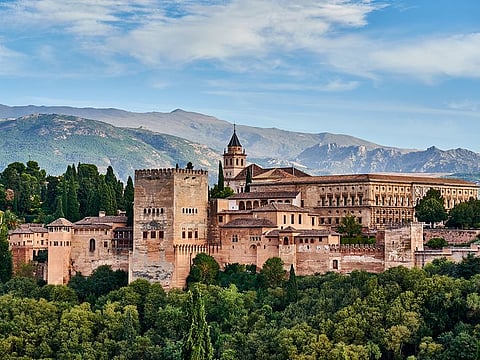Selfies and self-reflection at the Alhambra
There is a timeless beauty in Granada that transcends the centuries

There are certain geographical locations on this planet that are timeless, a confluence of creeds, histories and politics. The Alhambra is such a place.
I wandered its magnificent walls and gardens, palaces and patios and gazed out on Granada and was touched by the hand of time reaching out over a thousand years. Standing on the ramparts, looking across at the old city below, it is a view largely unchanged down the centuries.
And it is easy to be lost in time and travel in my mind back to a time when much of Spain was an Arab kingdom, an era, historians say, where culture and learning flourished, where Muslims, Christians and Jews lived mostly in harmony.
The red- and brown-bricked walls have stood sentinel over the city for the best part of a thousand years and it is still possible to feel the presence of those who have gone before.
Certainly, the craftsmen who delicately chiselled and carved the geometric patterns in the high ceilings of so much of the palace complexes leave their mark still today on the thousands who gaze up in awe at their mastery.
Breath of a craftsman
It is possible to envisage these ancient souls still at work, the delicate clinking and tapping sounds of wooden hammers on metal chisels held in hardened dust-caked hands.
You can almost feel the breath of a craftsman as he blows the dust aside to examine his work. Or the ancient engineers with plumb lines and protractors as they watch their project rise brick upon brick.
There are few such places left. This reminds so much of the scale and majesty of the temples of Angkor Wat. The Taj Mahal and Machu Picchu too, I suspect.
I sit in the carefully manicured gardens and watch as the swifts of summer flitter with such joy over the grounds and tourists who tick it off their bucket lists. Bees bounce from flower to shrub, gathering nectar — just as they have done down through time.
Water, flowing, in ponds, in fountains, is so central to this ancient palace. It ripples through channels that flow through time itself, a reminder to us all, regardless of when we pass through this place, that it is the key to life itself.
There are neatly tendered vegetable gardens that speak to the bounty of this place. Olives to be plucks, vines to be pressed, figs and oranges falling from trees, peas and aubergines, tomatoes and much of nature’s generosity to hand.
Silent columns and carvings, captured forever
In grand, high-vaulted and richly carved halls, the courtiers and viziers still vie for sway when my eyes are closed. The majlis of a millennium ago are still in session, their debates still reverberating in the silent columns and carvings, captured forever.
There is a fine arts gallery that holds the words of Spanish artists, their work mostly dark and foreboding, a harbinger of the Inquisition that would soon follow the fall of this palace and the end of Muslim rule in 1492.
That date, I remind myself, is the same where Christopher Columbus was dispatched to find the New World of the Americans and claim it for the new rulers of Spain, King Ferdinand and Queen Isabella — and their religion.
The Alhambra, its beauty, its timelessness, stand as a monument, a temporal edifice of the old and the new. There is no other such palace complex standing across the modern Muslim world that speaks through the centuries of art and learning, medicine and mathematics, science and society.
The young now who visit in search of the perfect selfie are blind to this beauty. Instagram is but a digital instant. Who will gaze in awe at their pixels centuries from now. Certainly not the carvers whose work transcends the ages.
Sign up for the Daily Briefing
Get the latest news and updates straight to your inbox








